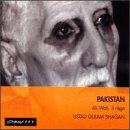| All Artists: Ustad Gulam Hassan Shagon Title: Ali Wali 3 Raga Members Wishing: 0 Total Copies: 0 Label: Opus 111 Original Release Date: 4/13/1999 Release Date: 4/13/1999 Album Type: Import Genres: International Music, Pop Styles: India & Pakistan, India, Pakistan Number of Discs: 1 SwapaCD Credits: 1 UPC: 709861302260 |
Search - Ustad Gulam Hassan Shagon :: Ali Wali 3 Raga
 | Ustad Gulam Hassan Shagon Ali Wali 3 Raga Genres: International Music, Pop
|
Larger Image |
CD Details |
CD ReviewsA masterpiece from a master Dave Maine | Lahore, Pakistan | 03/15/2000 (5 out of 5 stars) "The above review focuses on technical aspects of the music, so I will try to do something different: give an impressionistic review for the benefit of someone who has never heard the record.Ustad Shagan has an astonishingly rich, mellow voice which is capable of remarkable fluidity. The ragas he sings are built around scales of just a few notes and much of his virtuosity is displayed through his ability to moan, growl, wail and keen throughout these surprisingly expressive scales. This music is very intense, but also (for me) trance-inducing. Don't put this record on to wash dishes by, or you'll never finish them.The instrumentation consists of swirling layers of sarangi (kind of a fiddle) and the insect-buzz drones of a sitar-like instrument whose name escapes me at the moment. Providing a throbbing, bouncing bass line is some excellent tabla playing. This two-handed drum is more than adequate to the task of anchoring the whirl of voices (Ustad Shagan's son accompanies him) and strings.This music contrasts strongly with - for example - Nusrat Fateh Ali Khan's qawwali, which involves lots of hand-clapping and chanting choruses; the deep classical ragas on offer here are superficially at least far calmer and more serene. This is not to say that the music is dull. It is not. It is otherworldly, like the soundtrack to another planet, or maybe Heaven. I have been fortunate enough to hear Ustad Shagan in concert two times, once in Morocco and once in Pakistan. Listening to this record is not exactly the same experience, but it comes close. Technically it is top-notch, and the disc is generous (the three ragas clock in at 70+ minutes). If you're not afraid of losing yourself in someone else's music, check it out." A TREASURE Gregory G Nipper | Omaha, NE United States | 01/24/2000 (5 out of 5 stars) "Pretty much a must for anyone interested in the world's musical traditions. This is the only recording available by a master--probably the greatest vocalist Pakistan has produced since the advent of recording technology. His career spans 65 years, but he is almost completely unknown in the West, having performed only twice outside Lahore, Pakistan. The ragas he performs are deeply rooted in the tradition of Hindustani music, specifically the Khayal style. This style is the most freely improvised, and relies on the virtuosity of the musicians, particularly the vocalist, to bring it alive. His vocal control astounded me; he expertly combines different vocal techniques, Akar (wordless vocals) and Bol-Alaps (the presentation of the words of a song in subtle combinations of notes). This is ecstatic music: each raga begins with a modal foundation and a strict set of rules, then progresses according to the inspiration felt by the group of musicians in the moment. Ustad Galam Shagan's music is a means of achieving the Khayal (Arabic "creative imagination") in which Akirah (heavenly things) are approached and (Dunya) left behind. The compositions soar, advanced improvisationally both horizontally and vertically according to the traditional style. The result is a triumph of human creativity and will--no exaggeration. This recording absolutely floored me. The rare opportunity to hear this recording is a gift of which I urge you to take advantage. (P.S. I lifted some of my information for this review from Pat Thomas' review in Resonance magazine--the review that prompted me to seek out this recording. Thanks for the tip.)"
|

 Track Listings (4) - Disc #1
Track Listings (4) - Disc #1